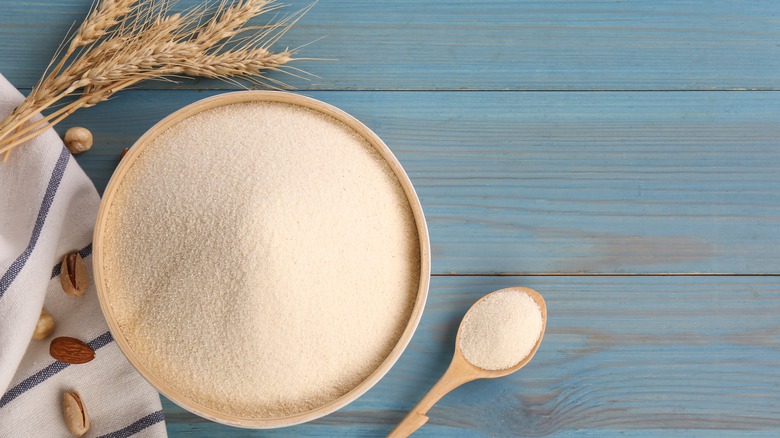Why People With Celiac Disease May Want To Steer Clear Of Semolina
Does the word "semolina" ring a bell? Even if it's the first time you're learning about this versatile ground grain, you have most probably eaten food containing this ingredient in the form of pasta, pizza, bread, couscous, or even pudding. Made from durum wheat, semolina is popular worldwide due to its mild nutty taste, earthy aroma, and health benefits that include promoting weight loss, improving blood sugar control, supporting heart health, and assisting with digestive health (via Healthline).
While most of us can enjoy foods made of semolina and savor every bite that signals our brain to release dopamine, people with gluten intolerance or celiac disease need to stay away from this high-gluten flour. Per Harvard Health Publishing, Celiac disease is a digestive and autoimmune disorder triggered by eating food containing gluten. The disease can cause damage to the small intestine and lead to long-term digestive complications, including the body's inability to absorb food nutrients.
The most effective and obvious treatment of celiac disease is to avoid gluten-containing foods or drinks (many types of beer are not gluten-free) and embrace gluten-free diets. In short, people with celiac disease have to avoid wheat, barley, rye, semolina, and even fried chicken since the crispy crust typically contains gluten.
The best gluten-free substitutes for semolina flour
Since semolina flour is readily available in any supermarket, finding a suitable substitute for this type of wheat flour can be problematic for people with celiac disease, gluten sensitivity, or even those who want to start a gluten-free diet. Thankfully, there are good semolina flour substitutes with different textures and tastes.
One of the best semolina flour substitutes is rice flour. It has a light texture and is ideal for baked goods, noodles, pasta, pastries, and cakes. If you're looking for a gluten-free, mineral-rich semolina alternative, amaranth flour could work best for you. It's packed with plenty of protein, fiber, and micronutrients. You can also use it as a thickener for soups and sauces. Buckwheat flour is another highly nutritious alternative and is ideal for being used as a thickening agent. If you feel that semolina flour alternatives have distinct tastes, you could always try potato flour since it's flavorless and goes well with other gluten-free flours.
You can use almond flour, sorghum flour, chickpea flour, arrowroot flour, and tapioca flour, too. There is also a gluten-free banana flour option you could try. Remember that all the aforementioned substitutes are excellent, but choosing the right one depends on what type of dish you plan to cook and the taste and texture you want to achieve. Therefore, do some research before starting your semolina flour alternative hunt.

